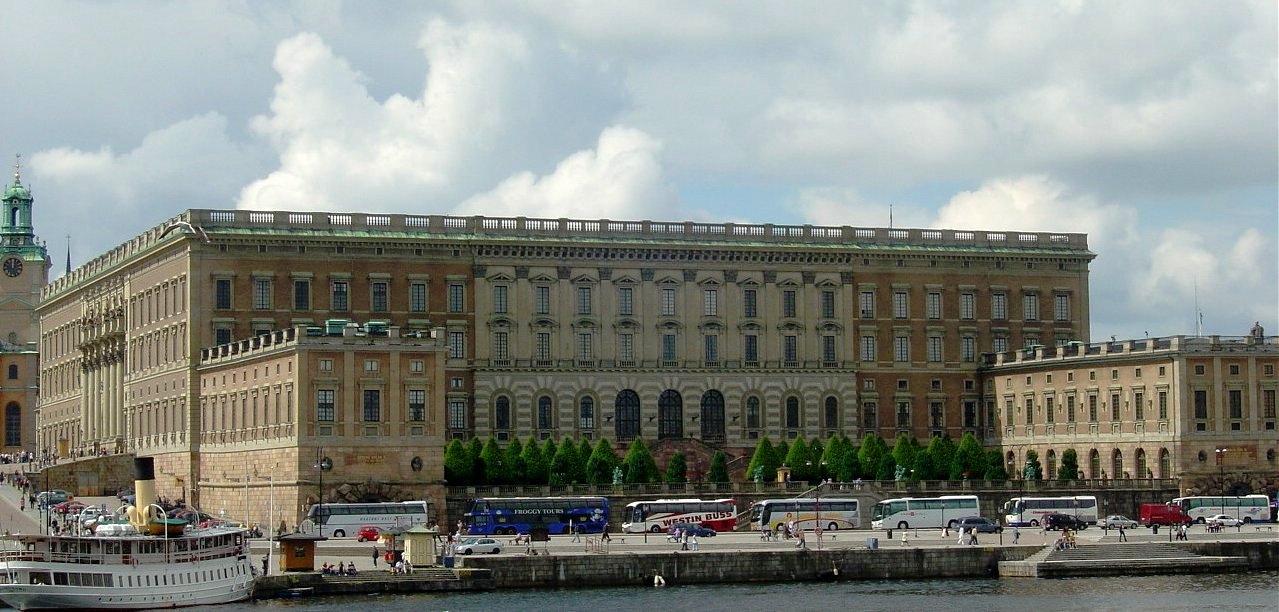- Stockholm Palace
Infobox Historic building

caption = The Royal Palace in Stockholm.
name = Stockholm Palace
location_town =Stockholm
location_country =Sweden
architect =Nicodemus Tessin the Younger
client =
engineer =
construction_start_date = 1697
completion_date = 1760
date_demolished =
cost =
structural_system =
style =The Stockholm Palace (Swedish: "Stockholms slott") is the
official residence and major royal palace of the Swedish monarch. (The private residence of the royal family isDrottningholm Palace ). Stockholm Palace is located onStadsholmen ("city island"), in "Gamla Stan " (the old town) in thecapital ,Stockholm . It neighbours theRiksdag , Sweden'sparliament .The personal offices of the monarch (currently Carl XVI Gustaf) and the other members of the
Swedish royal family as well as the administrative offices of theRoyal Court of Sweden are located there. The palace is also used for representative purposes by the king whilst performing his duties as thehead of state .The southern façade is facing the grand-style slope
Slottsbacken ; the eastern façade is borderingSkeppsbron , a pompous quay passing along the eastern waterfront of the old town; on the northern front isLejonbacken , a system of ramps named after the sculpted lions on the stone railings; and the western wings border the open spaceHögvaktsterrassen .History
The first building on this site was a
fortress with a coretower built in the13th century byBirger Jarl to defendLake Mälaren . The fortress grew to a palace, named Tre Kronor ("Three Crowns") after the core towers' spire.In the late
16th century , much work was done to transform the old fortress into a Renaissance-stylepalace under King John III. In1690 , it was decided to rebuild the palace inBaroque style after a design byNicodemus Tessin the Younger . In1692 , work began on the northern row. It was complete in1697 , but much of the palace burned to the ground following a fire onMay 7 ,1697 .The palace was rebuilt by
Nicodemus Tessin the Younger , with half-round wings around the outer westerncourtyard finished in1734 , the palace church finished in the1740s , and the exterior finished in1754 . The royal family moved to the palace with the southwest, southeast, and northeast wings finished. The northwest wing was finished in1760 . In the north, the "Lejonbacken" ("Lion's Slope") was built from1824 to1830 . Its name comes from thelion sculpture s that stand there.The palace is guarded by the "Högvakten", a
royal guard of members of theSwedish Armed Forces . The guard dates back to the early16th century .The palace today
The palace is built of
brick , with midsections of the west, south, and eastfaçade s covered bysandstone . The roof slopes slightly inwards. Theroof is covered withcopper and is surrounded by a stonebalustrade which stretched around the entire main building.The palace has 609 rooms and is one of the largest royal palaces in the world still in use for its original purpose. The palace consists of four rows: western, southern, eastern, and northern. The southern façade represents the nation, the west façade represents the king, the east façade represents the queen, and the northern façade represents the common royal. From west to east the palace façade is 115 m (without wings); from north to south the palace façade is 120 m. These four rows surround the inner courtyard.
From the main buildings' corners, four wings stretch out east and west. All wings are 48 m long and 16 m wide except the southwest wing which is only 11 m. The irregularity is hidden by two free-standing half-round wings that surround the outer courtyard. The "Logården" ("Lynx Yard") is a small garden between the southeast and northeast wing.
Interior
The western row
Walking up Västra Trapphuset (Western Staircase), a visitor will find the entrance to the Bernadotte Apartment to the left on the second floor, and the entrance to Ordenssalarna (Halls of the Orders of Chivalry) to the right. On the third floor lies The Guest Apartment (left side), and the entrance to the state apartment (right).
The eastern row
One stair down lies
Livrustkammaren , Sweden's oldest museum, which contains old weapons, uniforms and also the crown jewels.The northern row
In the northern row lie the king's and queen's suites (which contains bedchambers, wardrobes and anterooms). In the northern row also lies the Feast apartment which contains the ball room Vita Havet (the White Sea). In the same row also lies Karl XI:s galleri (Charles XI's gallery). On the bottom floor lies the exhibition part of the palace. One stair down lies Museum Tre Kronor, located in the old palace's cellar. One stair up lies Konseljrummet (the Council Room).
The southern row
One stair up lies Rikssalen and the Palace Church. Rikssalen is at the west and the Palace Church is at the east. One stair down lies Skattkammaren (the Treasure Chamber) which contains the Swedish crown jewels.
The northeast wing
In the northeast wing lies Gustav III's "antikmuseum" (museum of antiques). It contains ancient sculptures found in
Italy .References
External links
* [http://www.royalcourt.se/theroyalpalaces/theroyalpalace.4.19fe5e61065eb9aeea80002742.html Official website]
Template group
list =
Wikimedia Foundation. 2010.
